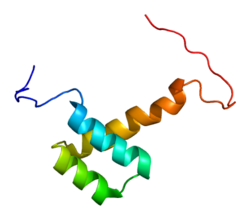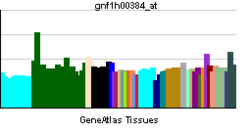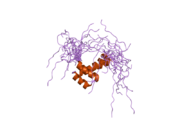- Orthodenticle homeobox 2
-
Homeobox protein OTX2 is a protein that in humans is encoded by the OTX2 gene.[1][2]
This gene encodes a member of the bicoid sub-family of homeodomain-containing transcription factors. The encoded protein acts as a transcription factor and may play a role in brain and sensory organ development. A similar protein in mice is required for proper forebrain development. Two transcript variants encoding distinct isoforms have been identified for this gene. Other alternative splice variants may exist, but their full length sequences have not been determined.[2]
Mutations in OTX2 can cause eye disorders including anophthalmia and microphthalmia.[3]
References
- ^ Kastury K, Druck T, Huebner K, Barletta C, Acampora D, Simeone A, Faiella A, Boncinelli E (Dec 1994). "Chromosome locations of human EMX and OTX genes". Genomics 22 (1): 41–5. doi:10.1006/geno.1994.1343. PMID 7959790.
- ^ a b "Entrez Gene: OTX2 orthodenticle homeobox 2". http://www.ncbi.nlm.nih.gov/sites/entrez?Db=gene&Cmd=ShowDetailView&TermToSearch=5015.
- ^ Verma AS, Fitzpatrick DR (2007). "Anophthalmia and microphthalmia". Orphanet J Rare Dis 2: 47. doi:10.1186/1750-1172-2-47. PMC 2246098. PMID 18039390. http://www.pubmedcentral.nih.gov/articlerender.fcgi?tool=pmcentrez&artid=2246098.
Further reading
- Hever AM, Williamson KA, van Heyningen V (2007). "Developmental malformations of the eye: the role of PAX6, SOX2 and OTX2". Clin. Genet. 69 (6): 459–70. doi:10.1111/j.1399-0004.2006.00619.x. PMID 16712695.
- Simeone A, Acampora D, Mallamaci A et al. (1993). "A vertebrate gene related to orthodenticle contains a homeodomain of the bicoid class and demarcates anterior neuroectoderm in the gastrulating mouse embryo". EMBO J. 12 (7): 2735–47. PMC 413524. PMID 8101484. http://www.pubmedcentral.nih.gov/articlerender.fcgi?tool=pmcentrez&artid=413524.
- Nagao T, Leuzinger S, Acampora D et al. (1998). "Developmental rescue of Drosophila cephalic defects by the human Otx genes". Proc. Natl. Acad. Sci. U.S.A. 95 (7): 3737–42. Bibcode 1998PNAS...95.3737N. doi:10.1073/pnas.95.7.3737. PMC 19906. PMID 9520436. http://www.pubmedcentral.nih.gov/articlerender.fcgi?tool=pmcentrez&artid=19906.
- Bobola N, Briata P, Ilengo C et al. (1999). "OTX2 homeodomain protein binds a DNA element necessary for interphotoreceptor retinoid binding protein gene expression". Mech. Dev. 82 (1–2): 165–9. doi:10.1016/S0925-4773(98)00162-2. PMID 10354480.
- Fong SL, Fong WB (1999). "Elements regulating the transcription of human interstitial retinoid-binding protein (IRBP) gene in cultured retinoblastoma cells". Curr. Eye Res. 18 (4): 283–91. doi:10.1076/ceyr.18.4.283.5360. PMID 10372988.
- Nakano T, Murata T, Matsuo I, Aizawa S (2000). "OTX2 directly interacts with LIM1 and HNF-3beta". Biochem. Biophys. Res. Commun. 267 (1): 64–70. doi:10.1006/bbrc.1999.1872. PMID 10623575.
- Strausberg RL, Feingold EA, Grouse LH et al. (2003). "Generation and initial analysis of more than 15,000 full-length human and mouse cDNA sequences". Proc. Natl. Acad. Sci. U.S.A. 99 (26): 16899–903. Bibcode 2002PNAS...9916899M. doi:10.1073/pnas.242603899. PMC 139241. PMID 12477932. http://www.pubmedcentral.nih.gov/articlerender.fcgi?tool=pmcentrez&artid=139241.
- Takeda K, Yokoyama S, Yasumoto K et al. (2003). "OTX2 regulates expression of DOPAchrome tautomerase in human retinal pigment epithelium". Biochem. Biophys. Res. Commun. 300 (4): 908–14. doi:10.1016/S0006-291X(02)02934-0. PMID 12559959.
- Martínez-Morales JR, Dolez V, Rodrigo I et al. (2003). "OTX2 activates the molecular network underlying retina pigment epithelium differentiation". J. Biol. Chem. 278 (24): 21721–31. doi:10.1074/jbc.M301708200. PMID 12663655.
- Puelles E, Annino A, Tuorto F et al. (2004). "Otx2 regulates the extent, identity and fate of neuronal progenitor domains in the ventral midbrain". Development 131 (9): 2037–48. doi:10.1242/dev.01107. PMID 15105370.
- Gerhard DS, Wagner L, Feingold EA et al. (2004). "The Status, Quality, and Expansion of the NIH Full-Length cDNA Project: The Mammalian Gene Collection (MGC)". Genome Res. 14 (10B): 2121–7. doi:10.1101/gr.2596504. PMC 528928. PMID 15489334. http://www.pubmedcentral.nih.gov/articlerender.fcgi?tool=pmcentrez&artid=528928.
- Boon K, Eberhart CG, Riggins GJ (2005). "Genomic amplification of orthodenticle homologue 2 in medulloblastomas". Cancer Res. 65 (3): 703–7. PMID 15705863.
- Di C, Liao S, Adamson DC et al. (2005). "Identification of OTX2 as a medulloblastoma oncogene whose product can be targeted by all-trans retinoic acid". Cancer Res. 65 (3): 919–24. PMID 15705891.
- Ragge NK, Brown AG, Poloschek CM et al. (2005). "Heterozygous Mutations of OTX2 Cause Severe Ocular Malformations". Am. J. Hum. Genet. 76 (6): 1008–22. doi:10.1086/430721. PMC 1196439. PMID 15846561. http://www.pubmedcentral.nih.gov/articlerender.fcgi?tool=pmcentrez&artid=1196439.
- Brunet I, Weinl C, Piper M et al. (2005). "The transcription factor Engrailed-2 guides retinal axons". Nature 438 (7064): 94–8. Bibcode 2005Natur.438...94B. doi:10.1038/nature04110. PMID 16267555.
- Chatelain G, Fossat N, Brun G, Lamonerie T (2007). "Molecular dissection reveals decreased activity and not dominant negative effect in human OTX2 mutants". J. Mol. Med. 84 (7): 604–15. doi:10.1007/s00109-006-0048-2. PMID 16607563.
- Lim J, Hao T, Shaw C et al. (2006). "A protein-protein interaction network for human inherited ataxias and disorders of Purkinje cell degeneration". Cell 125 (4): 801–14. doi:10.1016/j.cell.2006.03.032. PMID 16713569.
- Heimbucher T, Murko C, Bajoghli B et al. (2007). "Gbx2 and Otx2 Interact with the WD40 Domain of Groucho/Tle Corepressors". Mol. Cell. Biol. 27 (1): 340–51. doi:10.1128/MCB.00811-06. PMC 1800652. PMID 17060451. http://www.pubmedcentral.nih.gov/articlerender.fcgi?tool=pmcentrez&artid=1800652.
PDB gallery External links
This article incorporates text from the United States National Library of Medicine, which is in the public domain.
Transcription factors and intracellular receptors (1) Basic domains (1.1) Basic leucine zipper (bZIP)Activating transcription factor (AATF, 1, 2, 3, 4, 5, 6, 7) · AP-1 (c-Fos, FOSB, FOSL1, FOSL2, JDP2, c-Jun, JUNB, JUND) · BACH (1, 2) · BATF · BLZF1 · C/EBP (α, β, γ, δ, ε, ζ) · CREB (1, 3, L1) · CREM · DBP · DDIT3 · GABPA · HLF · MAF (B, F, G, K) · NFE (2, L1, L2, L3) · NFIL3 · NRL · NRF (1, 2, 3) · XBP1(1.2) Basic helix-loop-helix (bHLH)ATOH1 · AhR · AHRR · ARNT · ASCL1 · BHLHB2 · BMAL (ARNTL, ARNTL2) · CLOCK · EPAS1 · FIGLA · HAND (1, 2) · HES (5, 6) · HEY (1, 2, L) · HES1 · HIF (1A, 3A) · ID (1, 2, 3, 4) · LYL1 · MESP2 · MXD4 · MYCL1 · MYCN · Myogenic regulatory factors (MyoD, Myogenin, MYF5, MYF6) · Neurogenins (1, 2, 3) · NeuroD (1, 2) · NPAS (1, 2, 3) · OLIG (1, 2) · Pho4 · Scleraxis · SIM (1, 2) · TAL (1, 2) · Twist · USF1(1.3) bHLH-ZIP(1.4) NF-1(1.5) RF-X(1.6) Basic helix-span-helix (bHSH)(2) Zinc finger DNA-binding domains (2.1) Nuclear receptor (Cys4)subfamily 1 (Thyroid hormone (α, β), CAR, FXR, LXR (α, β), PPAR (α, β/δ, γ), PXR, RAR (α, β, γ), ROR (α, β, γ), Rev-ErbA (α, β), VDR)
subfamily 2 (COUP-TF (I, II), Ear-2, HNF4 (α, γ), PNR, RXR (α, β, γ), Testicular receptor (2, 4), TLX)
subfamily 3 (Steroid hormone (Androgen, Estrogen (α, β), Glucocorticoid, Mineralocorticoid, Progesterone), Estrogen related (α, β, γ))
subfamily 4 NUR (NGFIB, NOR1, NURR1) · subfamily 5 (LRH-1, SF1) · subfamily 6 (GCNF) · subfamily 0 (DAX1, SHP)(2.2) Other Cys4(2.3) Cys2His2General transcription factors (TFIIA, TFIIB, TFIID, TFIIE (1, 2), TFIIF (1, 2), TFIIH (1, 2, 4, 2I, 3A, 3C1, 3C2))
ATBF1 · BCL (6, 11A, 11B) · CTCF · E4F1 · EGR (1, 2, 3, 4) · ERV3 · GFI1 · GLI-Krüppel family (1, 2, 3, REST, S2, YY1) · HIC (1, 2) · HIVEP (1, 2, 3) · IKZF (1, 2, 3) · ILF (2, 3) · KLF (2, 3, 4, 5, 6, 7, 8, 9, 10, 11, 12, 13, 14, 15, 17) · MTF1 · MYT1 · OSR1 · PRDM9 · SALL (1, 2, 3, 4) · SP (1, 2, 4, 7, 8) · TSHZ3 · WT1 · Zbtb7 (7A, 7B) · ZBTB (16, 17, 20, 32, 33, 40) · zinc finger (3, 7, 9, 10, 19, 22, 24, 33B, 34, 35, 41, 43, 44, 51, 74, 143, 146, 148, 165, 202, 217, 219, 238, 239, 259, 267, 268, 281, 295, 300, 318, 330, 346, 350, 365, 366, 384, 423, 451, 452, 471, 593, 638, 644, 649, 655)(2.4) Cys6(2.5) Alternating composition(3) Helix-turn-helix domains (3.1) HomeodomainARX · CDX (1, 2) · CRX · CUTL1 · DBX (1, 2) · DLX (3, 4, 5) · EMX2 · EN (1, 2) · FHL (1, 2, 3) · HESX1 · HHEX · HLX · Homeobox (A1, A2, A3, A4, A5, A7, A9, A10, A11, A13, B1, B2, B3, B4, B5, B6, B7, B8, B9, B13, C4, C5, C6, C8, C9, C10, C11, C12, C13, D1, D3, D4, D8, D9, D10, D11, D12, D13) · HOPX · IRX (1, 2, 3, 4, 5, 6, MKX) · LMX (1A, 1B) · MEIS (1, 2) · MEOX2 · MNX1 · MSX (1, 2) · NANOG · NKX (2-1, 2-2, 2-3, 2-5, 3-1, 3-2, 6-1, 6-2) · NOBOX · PBX (1, 2, 3) · PHF (1, 3, 6, 8, 10, 16, 17, 20, 21A) · PHOX (2A, 2B) · PITX (1, 2, 3) · POU domain (PIT-1, BRN-3: A, B, C, Octamer transcription factor: 1, 2, 3/4, 6, 7, 11) · OTX (1, 2) · PDX1 · SATB2 · SHOX2 · VAX1 · ZEB (1, 2)(3.2) Paired box(3.3) Fork head / winged helix(3.4) Heat Shock Factors(3.5) Tryptophan clusters(3.6) TEA domain(4) β-Scaffold factors with minor groove contacts (4.1) Rel homology region(4.2) STAT(4.3) p53(4.4) MADS box(4.6) TATA binding proteins(4.7) High-mobility group(4.10) Cold-shock domainCSDA, YBX1(4.11) Runt(0) Other transcription factors (0.2) HMGI(Y)(0.3) Pocket domain(0.6) Miscellaneoussee also transcription factor/coregulator deficiencies
B bsyn: dna (repl, cycl, reco, repr) · tscr (fact, tcrg, nucl, rnat, rept, ptts) · tltn (risu, pttl, nexn) · dnab, rnab/runp · stru (domn, 1°, 2°, 3°, 4°)Categories:- Human proteins
- Transcription factors
- Chromosome 14 gene stubs
Wikimedia Foundation. 2010.



